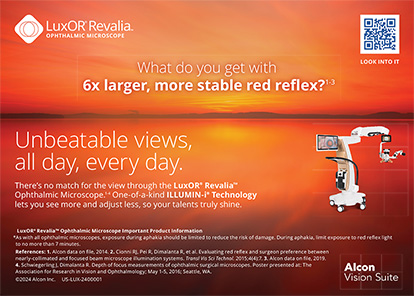We cataract surgeons may be at the threshold of a change in the therapeutic treatment during cataract surgery. Fifteen years ago, if we got the IOL behind the iris, the eye was intact, and the stitches were in place, we told patients that they were doing very well. We limited their activities and told them to come back in 4 to 6 weeks to have their stitches removed. In today's world of better phaco technology, smaller cataract incisions, and premium IOLs, we are striving to meet patients' rising expectations by providing earlier visual recovery and a "wow" effect similar to what individuals experience after LASIK surgery. Patients paying for premium lenses desire minimally invasive surgery and the ability to return to their daily activities with optimal vision within a day. Exceeding their expectations is the key to having them communicate the benefits of their cataract surgery to friends.
The way to more impressive outcomes and faster visual recovery after cataract surgery may lie in the cornea.
TESTING
Only recently have we come to appreciate the clinical and visual significance of contrast sensitivity and retinal thickness to cataract surgical outcomes, thanks in large part to the increased sophistication of our diagnostic and testing procedures. For example, optical coherence tomography provides objective measurements of macular edema that is not evident with a direct fundus examination. We also recognize that Snellen visual acuity is not an accurate representation of patients' quality of vision. Dark letters on a bright white background are not what people see in the real world.
Similarly, the cornea may look crystal clear at the slit lamp, but this examination is too gross. Like optical coherence tomography, pachymetry can provide objective measurements—in this case of corneal edema. This information enables us to determine whether minimizing corneal inflammation will provide the next step in maximizing the results of cataract surgery.
OPTIMIZING THE FUNCTION OF THE ENDOTHELIAL PUMP
Neurosurgeons treat surgical and trauma patients peri- and postoperatively with pulsed high doses of intravenous steroids in order to minimize or avoid damage to neural tissue.1,2 The corneal endothelium is a part of the neural ectoderm and is in many ways similar to brain tissue. It would therefore make sense if a high-dose course of a potent topical steroid were beneficial in cataract surgery as well. In fact, in the FDA trial of Durezol (Sirion Therapeutics, Tampa, FL), corneas treated with this medication four times daily cleared more rapidly than controls (P<.0001).3
In the past, the only way to achieve therapeutic levels of corticosteroids in the anterior chamber was intracamerally. When topical prednisolone acetate was ineffective, intracameral corticosteroids could reverse allograft rejection.4 In addition, intracameral corticosteroids have been shown to improve the lenticle's adherence in Descemet's stripping with automated endothelial keratoplasty, presumably due to improved endothelial function.5
We have performed preliminary studies to test the hypothesis that high doses of a potent corticosteroid could be advantageous in cataract surgery. We found that high doses of Durezol peri- and postoperatively significantly affect corneal thickness and edema. Specifically, patients instilled four drops of Durezol at home every 15 minutes starting 2 hours before surgery and then received three drops every 15 minutes upon arrival at the surgery center. They administered the drug approximately every hour during the first day after surgery. The dosing was then tapered to q.i.d for 1 week and then b.i.d. for a final week. At that point, the steroid was discontinued. Control patients followed a standard postoperative regimen of treatment q.i.d. with prednisolone acetate.
CONCLUSION
In our preliminary studies, no problems with safety have arisen. We do not anticipate observing corneal toxicity, because the steroid treatment is fairly short term. We will certainly be alert for this complication, which occurred infrequently in Durezol's FDA trials. Another potential problem is elevated IOP in response to steroid treatment, but we did not expect or observe this complication. The peak incidence of IOP spikes is generally 6 weeks after cataract surgery, and dosing of the steroid concludes after 2 weeks. Patients follow a standard regimen of nonsteroidal therapy for 6 weeks postoperatively as prophylaxis against cystoid macular edema.
Based on our preliminary data, we are now instituting a multicenter prospective clinical trial to determine if frequent, high doses of a potent steroid immediately before and after cataract surgery and for the first 2 weeks postoperatively effectively minimize corneal edema and improve outcomes. If this research bears out the results of our preliminary studies, we anticipate a paradigm shift in the field of cataract surgery in which a potent perioperative corticosteroid is used immediately pre- and postoperatively in a pulsed fashion.
Eric D. Donnenfeld, MD, is a professor of ophthalmology at NYU and a trustee of Dartmouth Medical School in Hanover, New Hampshire. Dr. Donnenfeld is in private practice with Ophthalmic Consultants of Long Island in New York. He is a consultant to Allergan, Inc., and Sirion Therapeutics. Dr. Donnenfeld may be reached at (516) 766-2519; eddoph@aol.com.
Edward J. Holland, MD, is a professor of ophthalmology at the University of Cincinnati in Ohio and the director of cornea at the Cincinnati Eye Institute. He is a consultant to Allergan, Inc., and Sirion Therapeutics. Dr. Holland may be reached at (859) 331-9000 ext. 3064; eholland@fuse.net.
Kerry D. Solomon, MD, is a professor of ophthalmology for the Storm Eye Institute at the Medical University of South Carolina in Charleston. He is a consultant to Allergan, Inc., and Sirion Therapeutics. Dr. Solomon may be reached at (843) 792-8854; solomonk@musc.edu.


